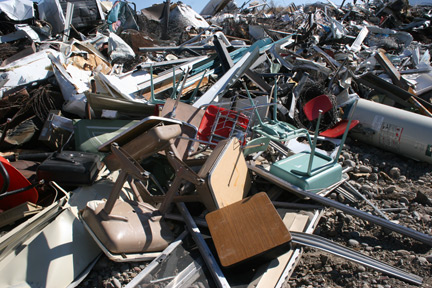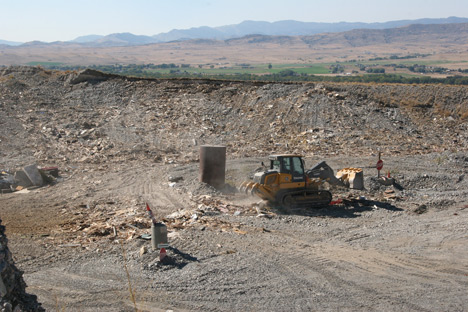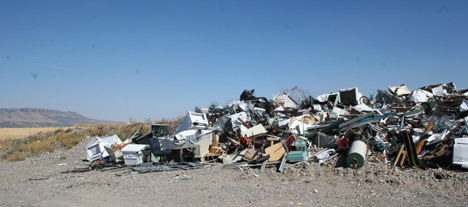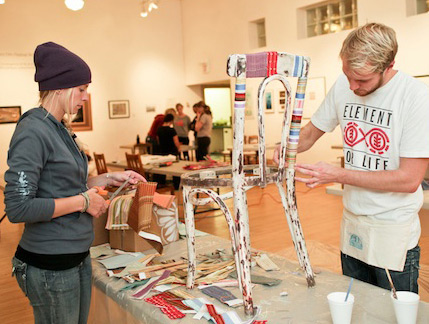A furniture waste solution in the making
One sunny September day, I found myself exploring the nooks & crannies of our county landfill looking for furniture. A towering pile of metal drew me to the upper level – old metal kids’ desks and chrome 50’s chairs haphazardly strewn throughout.

Vintage kids’ desks in the landfill – so many possibilities!
I was here to document the plight of sofas by photographing this one tiny part of our nation’s disposal system (our small county of 16,000 borders Yellowstone National Park).
Why sofas?
I chose to focus on sofas (rather than chairs or other furniture) because I had just come out of an experience that I did not want to repeat, in the position of sofa executioner… I had contracted with a local furniture store to handle their repairs, and found myself inspecting a brand new sofa that had been dropped during delivery. When it was determined that I couldn’t repair it for less than the price of (another) new sofa – and still make a living wage – I realized it would end up here. At the landfill.
A sofa’s plight
I looked around, wondering what they did with those big pieces. Then, I caught a movement out of the corner of my eye, and I heard a big engine start up. A Caterpillar track loader was beginning to move on the lower level, and it was moving toward – a sofa! I snapped a few photos as the CAT crushed it flat on the first pass, then proceeded to crunch back & forth over it several more times until there was nothing left but a pile of broken wood. Then, I noticed the slopes surrounding the pit were littered with broken wood.

Cat-tractor crushes sofa
This made me wonder exactly how much furniture our little town sends to the landfill. When I asked the owner of the local thrift store how many sofas they throw away each week, she told me their average is about one sofa per week. Doing the math, that’s 52 sofas per year for our little town – just from the thrift store. And remember, this doesn’t include chairs or any other furniture.
Now assuming that our small county reflects an average for the state and for the entire country, a simple extrapolation of the numbers based on population yields:
- 3,466 sofas thrown away each year by Montanans alone, and
- 1,109,120 sofas thrown away by Americans

Metal & furniture in a Montana landfill
After a quick web search for statistics, I found out this is most likely a conservative estimate. So what’s wrong with this picture?
Why is so much furniture being WASTED?
It’s a question of cost vs quality. During my short stint in furniture repair, I gained insight into today’s furniture industry that started me on a mission to change it. Did you know that chip board or particle board form the structural foundation of most low- to mid-priced sofas. If you don’t know what those materials are, suffice to say, they are not repairable. It breaks, you say ‘buh-bye’. Essentially, we all get to fall into the old ‘planned obsolescence’ trap every time we’re forced to choose the ‘economy’ sofa over the better-built version that’s made of solid wood. Check out this oEcotextiles post to learn how to choose a high quality sofa.
We are the solution
That visit to the landfill was 5 years ago (2011). I didn’t know it at the time, but the solution was beginning to form of its own accord – even then. Our communities, no matter how big or small, hold more power to change the world than any one person could imagine. And I’m talking BIG changes – that transform the way we do business – the way we build things, and the way we dispose of our ‘stuff’ when we’re done with it. Our furniture has to be a part of that.
The Maker Movement
The term has only recently come into use, but it’s not a new concept. It has roots in the home crafter movement, the earliest version of which was quilting bees – people pooling their resources to create something together. They shared not just tools & good company, but also creative ideas. Today’s Maker Movement is the rebirth of this concept, and it’s taking the form of community Maker Spaces.

Redesigning a chair in a maker space (photo: ChiekoHorn.com)
First appearing in the early 2000’s, and focused mainly around technology (as in 3D printing), Maker Spaces have evolved to become community centers where people come together to share tools & materials and to learn new skills from each other. These collaborative learning environments – located in libraries, schools & art centers as well as corporate campuses like Google and Apple – are set up to stretch people outside the ‘traditional’ learning environment.
How the Maker Movement can transform the way we buy furniture
I was so excited when I made the connection between the Maker Movement and my vision for the transformation of today’s ‘throwaway’ furniture industry…
Imagine this: Let’s say you have an antique chair that’s been passed down in your family. Even though it’s solidly built, it’s in sad shape after years of rough-housing kids & pets. You take it in to your local ‘reFurniture’ store, or ‘maker center’, where you can either have it refurbished, or trade it in for another style of old-but-solid chair that has more appeal to you. For the restoration, you have three choices available to you right there at the center. You can:
- Hire a professional upholsterer to restore your sofa.
- Save some money, and hire an experienced apprentice to do the work.
- Save even more by taking a class and doing the upholstery yourself, with the option of training as an apprentice to get paid do the work for others as you learn.
I don’t know exactly what this would look like in actual practice, but I LOVE the idea. It paints a picture of a cycle that brings people together, rejuvenates an age-old tradition, and brings furniture into the circular economy.
Makerspaces are born out of a mindset of community partnership, providing tools and education to enable members to design & create things that wouldn’t be possible for most individuals working alone.
Cool idea. thanks for sharing.
From the Living Home Furniture site:
Comment by Darcey from TheCompassionateHome.com (Jan 23, 2017) –
I’m absolutely in love with this idea of creating a community “maker space”! I think your concept to include restoring furniture is excellent, especially if one could train as an apprentice under someone experienced in upholstering/furniture making–and get paid while learning to refinish furniture for people who don’t want to do it themselves. There’s a building in my hometown that I’d love to use for such a place. It’s a large 3-story brick building that used to make things out of brass. I actually had a studio room there once in my early twenties, and just learned they are selling the whole building (for more than I could ever imagine!!) This dream maker space would be outfitted with woodworking equipment, lathes, CNC machines, laser cutters, 3D printers, computers with Adobe design software, large format printers, screen printing equipment/supplies, painting equipment/supplies, and craftsmen/women who would be willing to offer workshops to the community in woodworking, upholstery, design, painting, up cycling–and more!. I have no difficulty with the vision–only wonder how I could ever make it a reality!!
—
Hey Darcy, That 3-story brick building sounds like the perfect situation for a maker space. I’m totally with you on the vision – don’t we all wish we had the financial resources to make our dreams into reality! Do you have any maker spaces already in existence in your area? I think about how the upholstery-focused maker space will manifest, as it must eventually (right?!?). I know there are maker spaces around the country that already incorporate upholstery, so there’s a start. I’m keeping that vision front and center and always open to creative collaborations to make things happen!